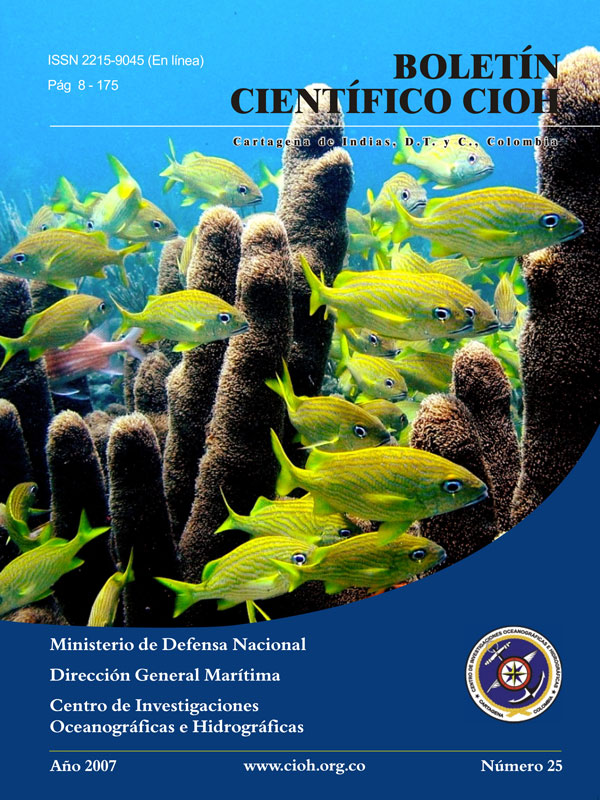Spatial Information for the control and management of the littoral at the Morrosquillo Gulf, Colombian Caribbean
DOI:
https://doi.org/10.26640/22159045.166Keywords:
Littoral, Control and management, DIMAR jurisdiction, Colombian CaribbeanAbstract
Due to the squatting of the public properties, mainly of the beaches and intertidal zones, by individuals, Colombia's Maritime Authority DIMAR (Dirección General Marítima), acting as the National Maritime Authority, in charge of controlling and managing such properties, has defined a conceptual model which utilizes spatial data, technical specifications and procedures to establish technically the limit of jurisdiction. The spatial information used comprised orthorectified digital air photographs taken during 2005, as well as three-dimensional information obtained with a LIDAR (Light Detection and Ranging) ALS40 sensor which allowed to conforma digital carthographic base appropriate for the control and management tasks of the littoral at the Morrosquillo Gulf.
The utilization of the spatial information for the control and management of the littoral at the Morrosquillo Gulf, comprised the definition of the conceptual model, the establishment of the needs of spatial information, the application of the conceptual model, the verification of its findings on the field, the analysis and discussion of the limits of DIMAR jurisdiction, the storing of the information of jurisdiction at the Institutional GIS of DIMAR and finally, the development of the control and administration of the littoral by the Port Authorities and the DIMAR based on the corresponding spatial data.
As a result of there search, the digital carthographic base of the area of study was obtained which is composed of 171 orthophotomaps to scale 1:2000, a database associated to the carthography resulting from a census of the littoral areas under jurisdiction, the interpolation from the Digital Terrain Model DTM-which was generated based on the LIDAR data, from the ellipsoidal height value of the highest tide line internal beach limit; location and quantification of the eroded and accretion produced by the construction of groins and breakwaters; spatialization and quantification of the areas subject to anthropic refilling; location and quantification of the flooding areas for an eventual sea level rise; trace of the preliminary limits of DIMAR jurisdiction and the structuring and storing of the spatial and alphanumeric information at the National Maritime Authority Corporative Geodatabase. Regarding the public properties under DIMAR jurisdiction, through there search it was established that 132.8 hectares correspond to beach field, the low tide fields occupy an area of 4,260 hectares and a strip of fifty meters of jurisdiction comprises 519.4 hectares.
Downloads
References
[2] Gillespie R, Butler M, Anderson N, Lucera H, Le Blanc C. MGDI: An Information Infrastructure to Support Integrated Coastal Management in Canada. Geo Coast. 2000; 1: 15-24.
[3] Afanador F, Camacho H. Establecimiento de la aptitud de uso como característica de calidad de la cartografía digital costera generada por el CCCP. Boletín Científico CCCP. 2004; 11:50-64.
[4] Burel T. Caracterisation de Modalites d'Evolution Recente de la Marge Continental e Nord-Colombienne [PhD Thesis]. Bordeaux: Université de Bordeaux; 1982.
[5] Knight R, Cooks M. Web- based spatial information system for coastal management and governance in South Africa. Biodiversity and Conservation Biology Department. University of the Western Cape. Bellville. 2002.
[6] THE CENTRE FOR ENVIRONMET, FISHERIES AND AQUACULTURE SCIENCE. Integrated Mapping of the UK Marine and Coastal Zone The Way Forward. Report of a MAFF-sponsored workshop held at CEFAS lowestoft Laboratory on 1718 June 1999; 1999.
[7] DEPARTMENT OF ENVIRONMENT AND NATIONAL RESOURCES, BUREAU OF FISHERIES AND AQUATIC RESOURCES AND DEPARTMENT OF THE INTERIOR AND LOCAL GOVERNMENT. Philippine Coastal Management Guide book Series No.1: Coastal Management Orientation and Overview. Philippines. 2001.
[8] King, S. Remote Sensing as an Information Source for Better Coastal Zone Management. Centre for Marine and Coastal Zone Management (CMCZM), University of Aberdeen, Elphinstone Road, Aberdeen, Scotland. 2004.
[9] Afanador F, Torres R, Gómez J, Gutiérrez J. LIDAR y fotografía aérea digital en la determinación del impacto del aumento en el nivel medio del mar en el sector de “La Boquilla”, Cartagena de Indias; Caribe colombiano. Boletín Científico CIOH. 2006; 24:94-106.
[10] Sperb R, Pacheco R, Khator R. Legaland socio-economic dynamics in coastal zone management: Agent-based Modeling of Spatial Processes. Coast GIS-International Symposium on GI Sand Computer Cartography for Coastal Zone Management; 2006.
[11] Járvelin K, Wilson T. On conceptual models for information seeking and retrieval research. Information research. An international electronic journal. 2003; 9(1).
[12] Valdemoro H. La influencia de la morfodinámica en los usos y recursos costeros [Ms C Thesis]. Cataluña: Universidad Politécnica de Cataluña; 2005.
[13] CONGRESO DE LA REPÚBLICA DE COLOMBIA. Decreto Ley 2324 de 1984.
[14] Afanador F, CastroI. Modelo conceptual para el control y administración de los litorales colombianos. Boletín Científico CIOH. 2006; 24: 73-93.
[15] Li R, Niu X, Ali T, Ma R, Elaksher A. Develpoment of a Web - based, mobile, spatial system for coastal management and decision making. Department of Civil & Environmental Engineering and Geodetic Science. The Ohio State University. Columbus. 2003.
[16] Li R. Integration of multi-source spatial information for costal management and decision making. Mapping and GIS Laboratory. The Ohio State University. Columbus. 2004.
[17] Guimet J. Coastal management in Catalonia. Case study. Spatial Data Infrastructure of Catalonia. Catalonia, España. 2005.
Downloads
Published
Issue
Section
License
Attribution — You must give appropriate credit, provide a link to the license, and indicate if changes were made. You may do so in any reasonable manner, but not in any way that suggests the licensor endorses you or your use.
NonCommercial — You may not use the material for commercial purposes.
NoDerivatives — If you remix, transform, or build upon the material, you may not distribute the modified material.
No additional restrictions — You may not apply legal terms or technological measures that legally restrict others from doing anything the license permits.



